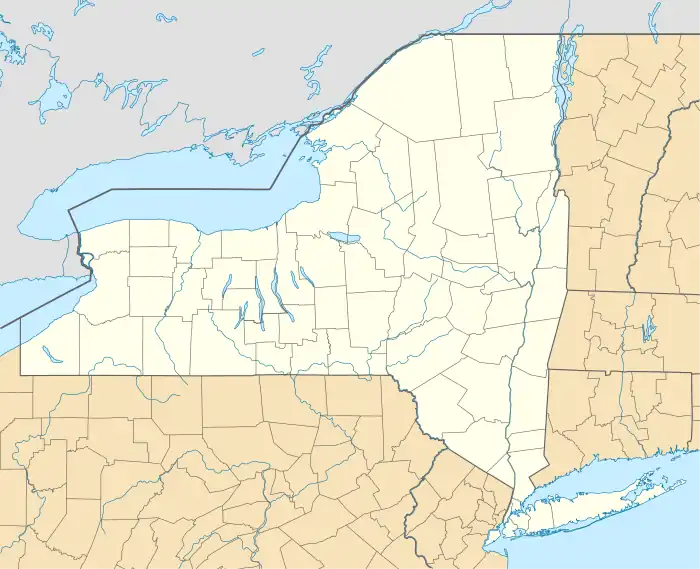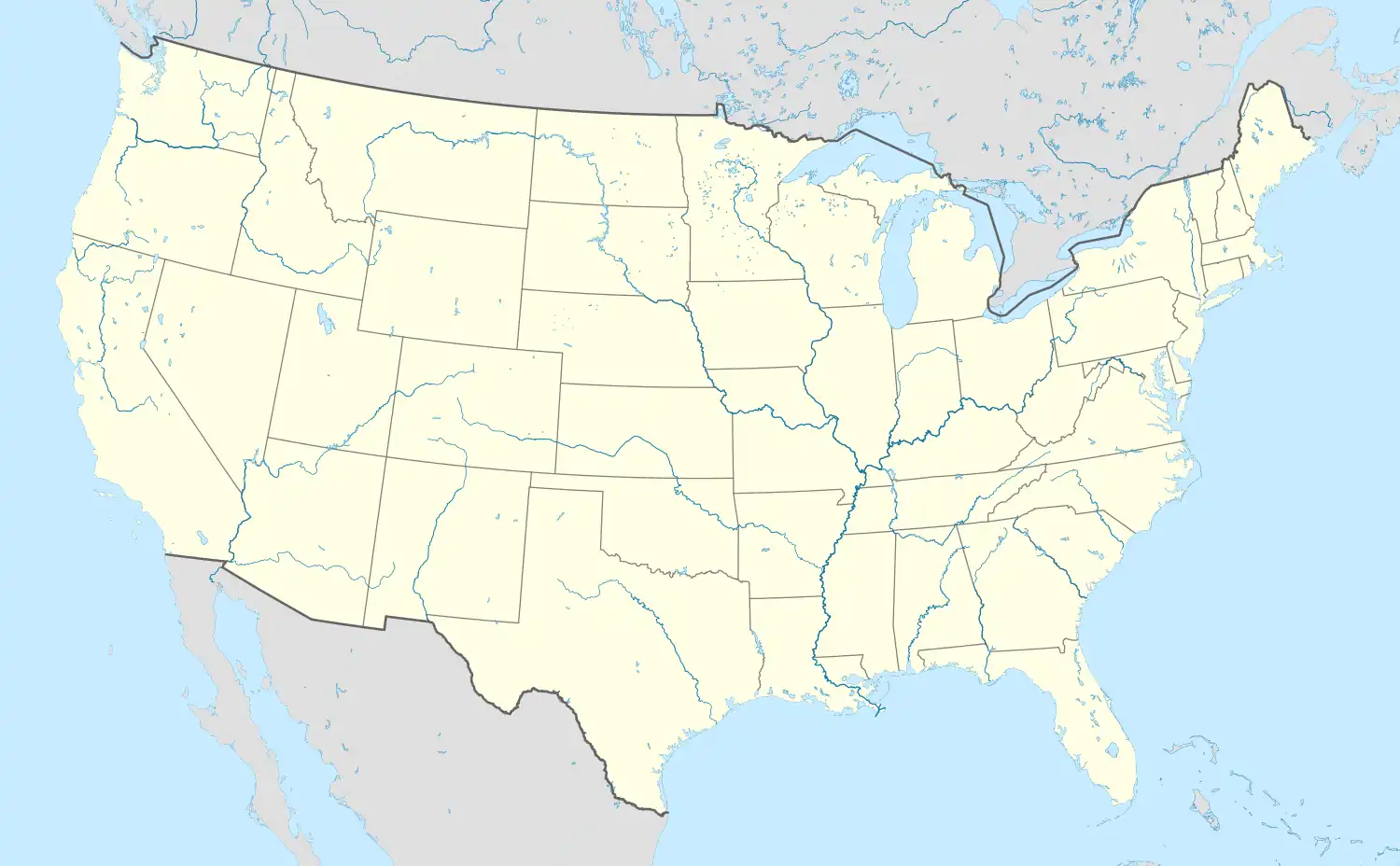Watervliet Arsenal
The Watervliet Arsenal /ˈwɔːtərvliːt/ is an arsenal of the United States Army located in Watervliet, New York, on the west bank of the Hudson River. It is the oldest continuously active arsenal in the United States, and today produces much of the artillery for the army, as well as gun tubes for cannons, mortars, and tanks. It has been a National Historic Landmark (NHL) since 1966.[2][3]
Watervliet Arsenal | |
Historic Iron Building | |
  | |
Interactive map showing the location for Watervliet Arsenal | |
| Location | Broadway Watervliet, New York |
|---|---|
| Coordinates | 42°43′06″N 73°42′31″W |
| Area | 142 acres (57 ha) |
| NRHP reference No. | 66000503 |
| Significant dates | |
| Added to NRHP | November 13, 1966[1] |
| Designated NHL | November 13, 1966[2] |

The arsenal was founded on July 14, 1813, to support the War of 1812. It was designated as the Watervliet Arsenal in 1817. It occupies 142 acres (57 ha) of land, approximately 8 miles (13 km) north of Albany, New York. The location is adjacent to the Hudson River. The site contains manufacturing, administrative offices and storage areas. It houses the Army's Benét Laboratories, which does product development, improvement, research, and testing for all artillery related engineering.
Tenant activities
The Arsenal has the historic Iron Building, which served as the home of the Watervliet Arsenal Museum. The museum was closed in October 2013 for security reasons.[4]
Recruiting Station Albany, the headquarters of a United States Marine Corps recruiting station, is located on the Arsenal.
In February 2009, the headquarters of the United States Army Recruiting Battalion Albany relocated to Watervliet Arsenal from its old location on Wolf Road.
History
1813–1823
The arsenal was chosen to be built at the edge of the village of Gibbonsville, directly opposite Troy, New York. It was chosen to be built there due to its key location on the Hudson River, only 60 miles (97 km) from Lake Champlain, 140 miles (230 km) from New York City, and a short distance via the Mohawk River to Lake Ontario. During the early stages of the War of 1812, attacks could be expected from many key ports and other locations.
At the time, the Colonel of Ordnance was Decius Wadsworth. He designated the arsenal to produce fixed ammunition and small articles of equipment including gun carriages, drag ropes, ladles, wormers, sponges, and shot. The original plot of land acquired by the Department of Ordnance was 12 acres (49,000 m2). Construction began in the summer of 1813 on fourteen buildings: south and north gun houses, a brick arsenal, two stables, a guard house, commanding officer's quarters, a woodshed, two enlisted men's quarters, a hospital and one office. The cost for the land was US$2,585.
1880s
Nearly 70 years after the arsenal produced its first products, it gained national prominence when it became the Army's first large caliber cannon manufacturer in the late 1880s. During this period, production changed from the manufacturing of saddles and gun carriages to cannons. Remnants of this period are still in operation today, via the continued use of historic Building 110, "The Big Gun Shop," for manufacturing missions. This gun shop once produced 16-inch guns and many other weapons for the United States Army Coast Artillery Corps.
See also
References
- "National Register Information System". National Register of Historic Places. National Park Service. January 23, 2007.
- "Watervliet Arsenal". National Historic Landmark summary listing. National Park Service. 2007-09-11.
- Robert W. Craig and Lauren Archibald (October 1985). "National Register of Historic Places Inventory-Nomination: Watervliet Arsenal" (pdf). National Park Service.
{{cite journal}}: Cite journal requires|journal=(help) and Accompanying 23 photos, exterior and interior, from 1984-1985, 1870, and 1875. (4.77 MiB) - Crowe, Kenneth (8 August 2014). "Plans dropped for revamped Watervliet Arsenal Museum". Albany Times Union. Retrieved 10 August 2014.
- "Watervliet Arsenal: What just happened?". www.army.mil.
- "FINAL RCRA FACILITY INVESTIGATION REPORT MAIN MANUFACTURING AREA WATERVLIET ARSENAL, Watervliet, New York" (PDF). New York Department of Environmental Conservation. US Army Corps of Engineers.
- Defense, United States Congress Senate Committee on Appropriations Subcommittee on Department of (1973). Department of Defense Appropriations for Fiscal Year 1974: Hearings Before a Subcommittee of the Committee on Appropriations, United States Senate, Ninety-third Congress, First Session, on H.R. 11575, an Act Making Appropriations for the Departartment of Defense for the Fiscal Year Ending June 30, 1974, and for Other Purposes. U.S. Government Printing Office. p. RA1-942.
- Michaels, Daniel. "At a Steam-Age Arsenal, U.S. Army Forges Cannons for a Digital Era, War in Ukraine". WSJ.
External links
- Official website
- Watervliet Arsenal on Facebook
- Historic American Engineering Record (HAER) No. NY-1-A, "Watervliet Arsenal, South Broadway, Watervliet, Albany County, NY", 5 photos, 7 measured drawings, 25 data pages, 1 photo caption page
- HAER No. NY-1-B, "Building No. 110", 78 photos, 24 data pages, 8 photo caption pages
- HAER No. NY-1-C, "Building No. 40", 20 photos, 20 data pages, 3 photo caption pages
- HAER No. NY-1-D, "Building No. 119", 3 photos, 8 data pages, 1 photo caption page
- HAER No. NY-1-E, "Building No. 129", 6 photos, 7 data pages, 1 photo caption page
- HAER No. NY-1-F, "Building No. 17", 5 photos, 8 data pages, 1 photo caption page
- HAER No. NY-1-G, "Building No. 41", 4 photos, 8 data pages, 1 photo caption page
- HAER No. NY-1-H, "Building No. 22", 8 photos, 8 data pages, 1 photo caption page
- HAER No. NY-1-I, "Building No. 15", 5 photos, 8 data pages, 1 photo caption page
- HAER No. NY-1-J, "Building No. 135", 20 photos, 9 data pages, 2 photo caption pages
- HAER No. NY-218, "Building 14", 2 photos, 1 photo caption page
- HAER No. NY-219, "Building 26", 2 photos, 1 photo caption page
- HAER No. NY-220, "Building 27", 2 photos, 1 photo caption page
- HAER No. NY-221, "Building 28", 3 photos, 1 photo caption page
- HAER No. NY-222, "Building 30", 4 photos, 1 photo caption page
- HAER No. NY-223, "Building 31", 1 photo, 1 photo caption page
- HAER No. NY-224, "Building 33", 2 photos, 1 photo caption page
- HAER No. NY-225, "Building 34", 1 photo, 1 photo caption page
- HAER No. NY-226, "Building 101", 2 photos, 1 photo caption page
- HAER No. NY-227, "Building 103", 2 photos, 1 photo caption page
- HAER No. NY-228, "Building 104", 3 photos, 1 photo caption page
- HAER No. NY-229, "Building 105", 18 photos, 1 data page, 2 photo caption pages
- HAER No. NY-230, "Building 106", 2 photos, 1 photo caption page
- HAER No. NY-231, "Building 108", 3 photos, 1 photo caption page
- HAER No. NY-232, "Building 112", 2 photos, 1 photo caption page
- HAER No. NY-233, "Building 116", 4 photos, 1 photo caption page
- HAER No. NY-234, "Building 32", 2 photos, 1 photo caption page

